Leveraging Digital Twin Technology with a Human-Centered Approach to Automate a Workstation in the Logistics Sector of Made in Italy: CHIMAR Use Case
Abstract
1. Introduction
2. Ergonomics
- Checklists, surveys, and reportsErgonomic assessment checklist are often a list of items that can be analyzed by employees, directors, supervisors, or experienced professionals. Those instruments are implemented to make sure that workers’ task are optimized for comfort and productivity, and for reducing the risk of work-related injuries.
- Observation-based methodsObservation-based methods are based on a numerical framework for ergonomic occupational risk assessments. The main limitation of those techniques is that they are focused mainly on assessing work postures, and do not concentrate on work rate and static loading. Sometimes, they are used as a basis to perform a computer-based strategy for strategic planning ergonomic analysis.
- Direct measurement methodsA direct measurement method is implemented when the evaluation of the worker’s exposure to risk and musculoskeletal activity is performed during the task execution. This is typically achieved by attaching various types of sensors directly to the worker’s body.
- Computer applicationsComputer-based applications rely on frameworks and procedures that integrate other methods with artificial intelligence techniques. The combination of observation-based and computer-based applications is seen in tools like the Ergonomic Assessment Worksheet (EAWS) and the Digital Human Model (DHM).
- Low risk: The risk of injury or musculoskeletal disorders is minimal, and the working conditions are generally safe and do not present significant physical stress.
- Medium-low risk: The risk is moderate but not immediate or severe. There are ergonomically suboptimal operations, but there are no particularly hazardous conditions.
- Medium risk: The risk is visible and significant but not severe enough to cause immediate injuries. The working conditions may lead to temporary discomfort or pain but not necessarily serious injuries.
- Medium-high risk: In this scenario, the risk is significant, with potential consequences for the worker’s health over the medium or long term, such as the risk of chronic musculoskeletal disorders.
- High risk: The risk is very high, with the likelihood of injuries or musculoskeletal disorders occurring in the short term. The working conditions are negative and present high potential for damage to health.
3. Methodology
- Time analysis.
- Motion capturing acquisition.
- Digital human simulation (digital twin).
- Ergonomic evaluation.
- Collaborative robot application.
3.1. Time Analysis
3.2. Motion Capturing Acquisition
3.3. Digital Human Simulation (Digital Twin)
3.4. Ergonomic Evaluation
- Section 0—Extra Points: Captures additional loads not included in other sections.
- Section 1—Postures: Evaluates body positions, including static postures and high-frequency movements. This section considers the symmetric and asymmetric postures based on duration and discomfort.
- Section 2—Action Forces: Assesses force exertion tasks (greater than 30 N with hands or 40 N with arms/whole body).
- Section 3—Manual Material Handling (MMH): Analyzes tasks involving carrying, holding, pushing, or pulling loads greater than 3 kg.
3.5. Collaborative Robot Application
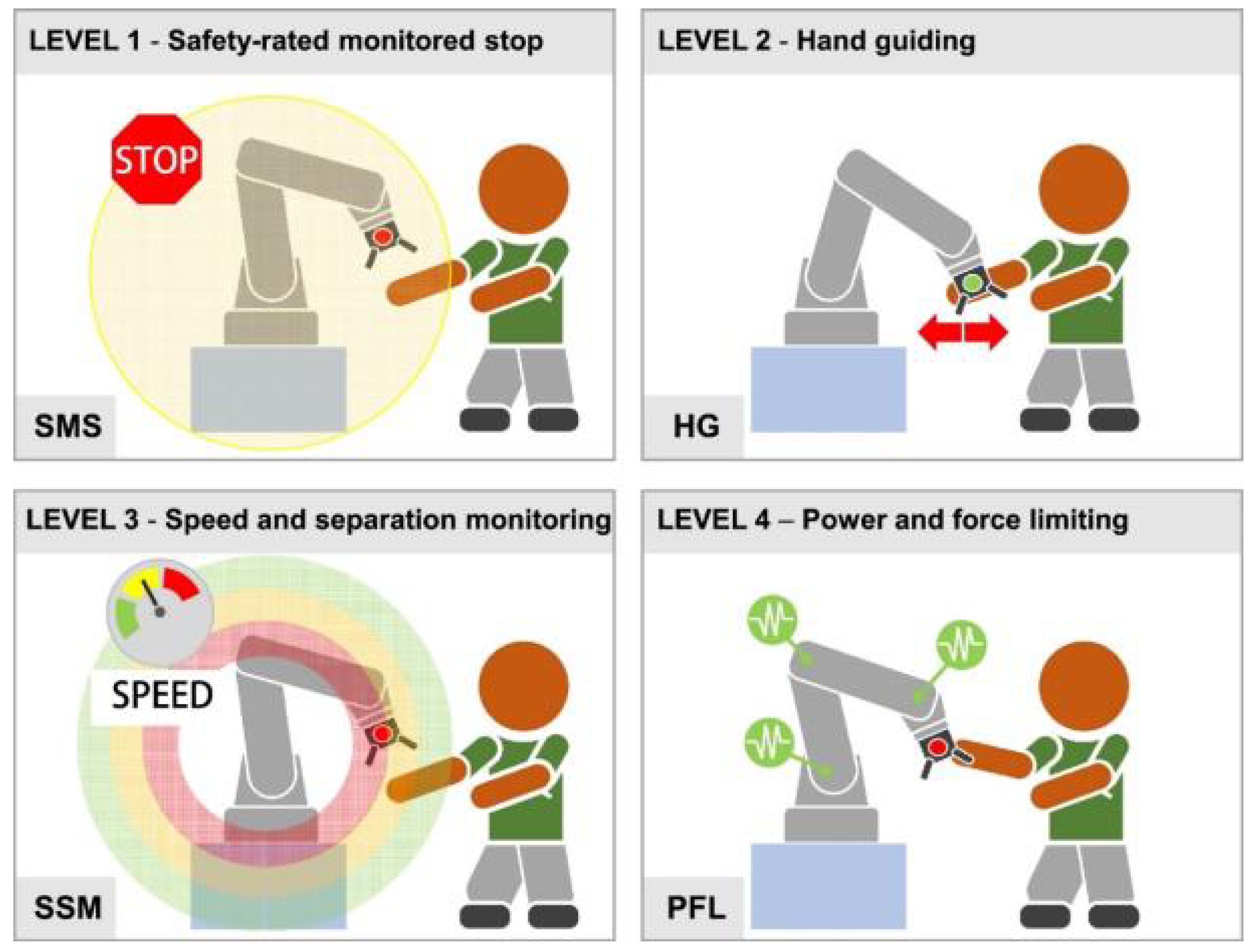
4. Use Case: CHIMAR
5. Methodology Implementation
5.1. Workstation Time Analysis
5.2. Workstation Motion Capturing Acquisition
- Sensor 1: head (Figure 5a).
- Sensor 2: neck (Figure 5a).
- Sensor 3: upper right arm (Figure 5a,b).
- Sensor 4: upper left arm (Figure 5a,b).
- Sensor 5: lower right arm (Figure 5a).
- Sensor 6: lower left arm (Figure 5a).
- Sensor 7: right hand (Figure 5a).
- Sensor 8: left hand (Figure 5a).
- Sensor 9: upper right leg (Figure 5a).
- Sensor 10: upper left leg (Figure 5a).
- Sensor 11: lower right leg (Figure 5a).
- Sensor 12: lower left leg (Figure 5a).
- Sensor 13: right foot (Figure 5a).
- Sensor 14: left foot (Figure 5a).
- Sensor 15: left shoulder (Figure 5b).
- Sensor 16: right shoulder (Figure 5b).
- Sensor 17: lower back (Figure 5b).
5.3. Workstation Digital Human Simulation (Digital Twin)
5.4. Workstation Ergonomic Evaluation
5.5. Collaborative Robot Application in the Workstation
6. Results
- Cycle time reduction.
- Ergonomic evaluation reduction.
- Robot simulation.
6.1. Cycle Time
6.2. Ergonomic Evaluation
6.3. Robot Simulation
7. Conclusions
Author Contributions
Funding
Institutional Review Board Statement
Informed Consent Statement
Data Availability Statement
Acknowledgments
Conflicts of Interest
References
- Golovianko, M.; Terziyan, V.; Branytskyi, V.; Malyk, D. Industry 4.0 vs. Industry 5.0: Co-existence, transition, or a hybrid. Procedia Comput. Sci. 2023, 217, 102–113. [Google Scholar] [CrossRef]
- Adel, A. Future of industry 5.0 in society: Human-centric solutions, challenges and prospective research areas. J. Cloud Comput. 2022, 11, 40. [Google Scholar]
- Ziatdinov, R.; Atteraya, M.S.; Nabiyev, R. The Fifth Industrial Revolution as a transformative step towards society 5.0. Societies 2024, 14, 19. [Google Scholar] [CrossRef]
- Leng, J.; Sha, W.; Wang, B.; Zheng, P.; Zhuang, C.; Liu, Q.; Wuest, T.; Mourtzis, D.; Wang, L. Industry 5.0: Prospect and retrospect. J. Manuf. Syst. 2022, 65, 279–295. [Google Scholar] [CrossRef]
- Xu, X.; Lu, Y.; Vogel-Heuser, B.; Wang, L. Industry 4.0 and Industry 5.0—Inception, conception and perception. J. Manuf. Syst. 2021, 61, 530–535. [Google Scholar]
- Raja Santhi, A.; Muthuswamy, P. Industry 5.0 or industry 4.0 S? Introduction to industry 4.0 and a peek into the prospective industry 5.0 technologies. Int. J. Interact. Des. Manuf. 2023, 17, 947–979. [Google Scholar]
- Rybnikár, F.; Kačerová, I.; Hořejší, P.; Šimon, M. Ergonomics evaluation using motion capture technology—Literature review. Appl. Sci. 2022, 13, 162. [Google Scholar] [CrossRef]
- Loske, D.; Klumpp, M.; Keil, M.; Neukirchen, T. Logistics Work, ergonomics and social sustainability: Empirical musculoskeletal system strain assessment in retail intralogistics. Logistics 2021, 5, 89. [Google Scholar] [CrossRef]
- Trstenjak, M.; Đukić, G.; Opetuk, T. Human Factors and Ergonomics in Logistics Activities by Principles of Industry 5.0. In Proceedings of the 1st Jordanian Conference on Logistics in the Mashreq Region (JCLM1), Amman, Jordan, 12–14 November 2023; p. 64. [Google Scholar]
- Cristaldi, L.; Esmaili, P.; Gruosso, G.; La Bella, A.; Mecella, M.; Scattolini, R.; Arman, A.; Susto, G.A.; Tanca, L. The MICS Project: A Data Science Pipeline for Industry 4.0 Applications. In Proceedings of the 2023 IEEE International Conference on Metrology for eXtended Reality, Artificial Intelligence and Neural Engineering (MetroXRAINE), Milan, Italy, 25–27 October 2023; IEEE: New York, NY, USA, 2023; pp. 427–431. [Google Scholar]
- Berti, N.; Arman, A.; Esmaili, P.; Zeynivand, M.; Battini, D.; Bianchini, D.; Cristaldi, L.; De Giuli, L.B.; Galeazzo, A.; Gruosso, G.; et al. Sustainability and Resilience in the MICS SPOKE8 project: The role of the Digital Twin. In Proceedings of the 2024 IEEE International Conference on Metrology for eXtended Reality, Artificial Intelligence and Neural Engineering (MetroXRAINE), Naples, Italy, 29–31 October 2024; IEEE: New York, NY, USA, 2024; pp. 669–673. [Google Scholar]
- Vijayakumar, V.; Sgarbossa, F.; Neumann, W.P.; Sobhani, A. Framework for incorporating human factors into production and logistics systems. Int. J. Prod. Res. 2022, 60, 402–419. [Google Scholar] [CrossRef]
- Sluchak, T.J. Ergonomics: Origins, focus, and implementation considerations. AAOHN J. 1992, 40, 105–112. [Google Scholar] [CrossRef]
- Irimie, S.I.; Irimie, S. Ergonomy and the ergonomist. historical and current references. Acta Tech. Napoc. Ser. Appl. Math. Mech. Eng. 2021, 64, 1232. [Google Scholar]
- Bortolini, M.; Botti, L.; Galizia, F.G.; Mora, C. Ergonomic Design of an Adaptive Automation Assembly System. Machines 2023, 11, 898. [Google Scholar] [CrossRef]
- Mali, S.; Vyavahare, R. An ergonomic evaluation of an industrial workstation: A review. Int. J. Curr. Eng. Technol. 2015, 5, 1820–1826. [Google Scholar]
- Zen, Z.H.; Widia, M.; Sukadarin, E.H. Ergonomics Risk Assessment Tools: A Systematic Review. Malays. J. Med. Health Sci. 2024, 20, 289–300. [Google Scholar]
- Berguer, R. The application of ergonomics in the work environment of general surgeons. Rev. Environ. Health 1997, 12, 99–106. [Google Scholar] [CrossRef]
- Sabino, I.; do Carmo Fernandes, M.; Cepeda, C.; Quaresma, C.; Gamboa, H.; Nunes, I.L.; Gabriel, A.T. Application of wearable technology for the ergonomic risk assessment of healthcare professionals: A systematic literature review. Int. J. Ind. Ergon. 2024, 100, 103570. [Google Scholar] [CrossRef]
- Naeini, H.S.; Karuppiah, K.; Tamrin, S.B.; Dalal, K. Ergonomics in agriculture: An approach in prevention of work-related musculoskeletal disorders (WMSDs). J. Agric. Environ. Sci. 2014, 3, 33–51. [Google Scholar]
- Loos, M.J.; Merino, E.; Rodriguez, C.M.T. Mapping the state of the art of ergonomics within logistics. Scientometrics 2016, 109, 85–101. [Google Scholar] [CrossRef]
- Hasanain, B. The Role of Ergonomic and Human Factors in Sustainable Manufacturing: A Review. Machines 2024, 12, 159. [Google Scholar] [CrossRef]
- Sgarbossa, F.; Grosse, E.H.; Neumann, W.P.; Battini, D.; Glock, C.H. Human factors in production and logistics systems of the future. Annu. Rev. Control 2020, 49, 295–305. [Google Scholar] [CrossRef]
- Zülch, M.; Zülch, G. Production logistics and ergonomic evaluation of U-shaped assembly systems. Int. J. Prod. Econ. 2017, 190, 37–44. [Google Scholar]
- Mocan, A.; Draghici, A. Reducing ergonomic strain in warehouse logistics operations by using wearable computers. Procedia Soc. Behav. Sci. 2018, 238, 1822–1829. [Google Scholar] [CrossRef]
- Grajewski, D.; Górski, F.; Zawadzki, P.; Hamrol, A. Application of virtual reality techniques in design of ergonomic manufacturing workplaces. Procedia Comput. Sci. 2013, 25, 289–301. [Google Scholar] [CrossRef]
- Battini, D.; Berti, N.; Finco, S.; Guidolin, M.; Reggiani, M.; Tagliapietra, L. WEM-Platform: A real-time platform for full-body ergonomic assessment and feedback in manufacturing and logistics systems. Comput. Ind. Eng. 2022, 164, 107881. [Google Scholar]
- Brosche, J.; Wackerle, H.; Augat, P.; Lödding, H. Individualized workplace ergonomics using motion capture. Appl. Ergon. 2024, 114, 104140. [Google Scholar] [CrossRef]
- Rahmani, R.; Jesus, C.; Lopes, S.I. Implementations of Digital Transformation and Digital Twins: Exploring the Factory of the Future. Processes 2024, 12, 787. [Google Scholar] [CrossRef]
- Trstenjak, M.; Benešova, A.; Opetuk, T.; Cajner, H. Human Factors and Ergonomics in Industry 5.0—A Systematic Literature Review. Appl. Sci. 2025, 15, 2123. [Google Scholar] [CrossRef]
- He, Q.; Li, L.; Li, D.; Peng, T.; Zhang, X.; Cai, Y.; Zhang, X.; Tang, R. From digital human modeling to human digital twin: Framework and perspectives in human factors. Chin. J. Mech. Eng. 2024, 37, 9. [Google Scholar] [CrossRef]
- Vujica-Herzog, N.; Buchmeister, B.; Breznik, M. Ergonomics, digital twins and time measurements for optimal workplace design. Hum. Factors Simul. 2022, 30, 1–12. [Google Scholar]
- Baratta, A.; Cimino, A.; Longo, F.; Nicoletti, L. Digital twin for human-robot collaboration enhancement in manufacturing systems: Literature review and direction for future developments. Comput. Ind. Eng. 2024, 187, 109764. [Google Scholar] [CrossRef]
- Nikolakis, N.; Siaterlis, G.; Bampoula, X.; Papadopoulos, I.; Tsoukaladelis, T.; Alexopoulos, K. A digital twin-enabled cyber-physical system approach for mixed packaging. In SPS2022; IOS Press: Amsterdam, The Netherlands, 2022; pp. 485–496. [Google Scholar]
- Ramasubramanian, A.K.; Mathew, R.; Kelly, M.; Hargaden, V.; Papakostas, N. Digital twin for human–robot collaboration in manufacturing: Review and outlook. Appl. Sci. 2022, 12, 4811. [Google Scholar] [CrossRef]
- Bilberg, A.; Malik, A.A. Digital twin driven human–robot collaborative assembly. Cirp Ann. 2019, 68, 499–502. [Google Scholar]
- Menolotto, M.; Komaris, D.S.; Tedesco, S.; O’Flynn, B.; Walsh, M. Motion capture technology in industrial applications: A systematic review. Sensors 2020, 20, 5687. [Google Scholar] [CrossRef]
- Salisu, S.; Ruhaiyem, N.I.R.; Eisa, T.A.E.; Nasser, M.; Saeed, F.; Younis, H.A. Motion Capture Technologies for Ergonomics: A Systematic Literature Review. Diagnostics 2023, 13, 2593. [Google Scholar] [CrossRef]
- Petrosyan, T.; Dunoyan, A.; Mkrtchyan, H. Application of motion capture systems in ergonomic analysis. Armen. J. Spec. Educ. 2020, 4, 107–117. [Google Scholar]
- Tao, F.; Xiao, B.; Qi, Q.; Cheng, J.; Ji, P. Digital twin modeling. J. Manuf. Syst. 2022, 64, 372–389. [Google Scholar]
- Hauge, J.B.; Zafarzadeh, M.; Jeong, Y.; Li, Y.; Khilji, W.A.; Wiktorsson, M. Employing digital twins within production logistics. In Proceedings of the 2020 IEEE International Conference on Engineering, Technology and Innovation (ICE/ITMC), Cardiff, UK, 15–17 June 2020; IEEE: New York, NY, USA, 2020; pp. 1–8. [Google Scholar]
- Berti, N.; Finco, S. Digital twin and human factors in manufacturing and logistics systems: State of the art and future research directions. IFAC PapersOnLine 2022, 55, 1893–1898. [Google Scholar] [CrossRef]
- Lin, Y.; Chen, L.; Ali, A.; Nugent, C.; Cleland, I.; Li, R.; Ding, J.; Ning, H. Human digital twin: A survey. J. Cloud Comput. 2024, 13, 131. [Google Scholar]
- Wang, B.; Zhou, H.; Li, X.; Yang, G.; Zheng, P.; Song, C.; Yuan, Y.; Wuest, T.; Yang, H.; Wang, L. Human Digital Twin in the context of Industry 5.0. Robot. Comput. Integr. Manuf. 2024, 85, 102626. [Google Scholar]
- Caputo, F.; Greco, A.; Fera, M.; Macchiaroli, R. Digital twins to enhance the integration of ergonomics in the workplace design. Int. J. Ind. Ergon. 2019, 71, 20–31. [Google Scholar]
- Maruyama, T.; Ueshiba, T.; Tada, M.; Toda, H.; Endo, Y.; Domae, Y.; Nakabo, Y.; Mori, T.; Suita, K. Digital twin-driven human robot collaboration using a digital human. Sensors 2021, 21, 8266. [Google Scholar] [CrossRef] [PubMed]
- Cibrario, V.; Vargas, M.; Fantuzzi, C.; Cavatorta, M.P.; Bagalà, A.N.; Bosani, E.; Dengel, D.; Schaub, M.; Delfs, N.; Fagerlind, E.; et al. Assessing ergonomics on cobot for an optimized integrated solution in early phase of product and process design. In Digital Human Modeling and Applied Optimization; AHFE Open Access: Amsterdam, The Netherlands, 2023; Volume 76, pp. 63–69. [Google Scholar]
- Brolin, E.; Högberg, D.; Hanson, L. Design of a Digital Human Modelling Module for Consideration of Anthropometric Diversity; AHFE Open Access: Amsterdam, The Netherlands, 2014; pp. 114–120. [Google Scholar]
- Tee, K.S.; Low, E.; Saim, H.; Zakaria, W.N.W.; Khialdin, S.B.M.; Isa, H.; Awad, M.; Soon, C.F. A study on the ergonomic assessment in the workplace. In Proceedings of the International Conference on Electrical and Electronic Engineering 2017 (IC3E 2017), Johor Bahru, Malaysia, 9–11 August 2017; AIP Conference Proceedings. AIP Publishing: Melville, NY, USA, 2017; Volume 1883. [Google Scholar]
- Schaub, K.G.; Mühlstedt, J.; Illmann, B.; Bauer, S.; Fritzsche, L.; Wagner, T.; Bullinger-Hoffmann, A.C.; Bruder, R. Ergonomic assessment of automotive assembly tasks with digital human modelling and the ‘ergonomics assessment worksheet’ (EAWS). Int. J. Hum. Factors Model. Simul. 2012, 3, 398–426. [Google Scholar] [CrossRef]
- El Zaatari, S.; Marei, M.; Li, W.; Usman, Z. Cobot programming for collaborative industrial tasks: An overview. Robot. Auton. Syst. 2019, 116, 162–180. [Google Scholar]
- Cardoso, A.; Colim, A.; Bicho, E.; Braga, A.C.; Menozzi, M.; Arezes, P. Ergonomics and human factors as a requirement to implement safer collaborative robotic workstations: A literature review. Safety 2021, 7, 71. [Google Scholar] [CrossRef]
- Taesi, C.; Aggogeri, F.; Pellegrini, N. COBOT applications—Recent advances and challenges. Robotics 2023, 12, 79. [Google Scholar] [CrossRef]
- ISO 10218-1:2011(E); Robots and Robotic Devices—Safety Requirements for Industrial Robots—Part 1: Robots. ISO Standards: Geneva, Switzerland, 2011.
- ISO 10218-2:2011(E); Robots and Robotic Devices–Safety Requirements for Industrial Robots—Part 2: Robot Systems and Integration. ISO Standards: Geneva, Switzerland, 2011.
- Wannasuphoprasit, W.; Gillespie, R.B.; Colgate, J.E.; Peshkin, M.A. Cobot control. In Proceedings of the International Conference on Robotics and Automation, Albuquerque, NM, USA, 20–25 April 1997; IEEE: New York, NY, USA, 1997; Volume 4, pp. 3571–3576. [Google Scholar]
- Lorenzini, M.; Lagomarsino, M.; Fortini, L.; Gholami, S.; Ajoudani, A. Ergonomic human-robot collaboration in industry: A review. Front. Robot. AI 2023, 9, 813907. [Google Scholar]
- Keshvarparast, A.; Berti, N.; Chand, S.; Guidolin, M.; Lu, Y.; Battaia, O.; Xu, X.; Battini, D. Ergonomic design of Human-Robot collaborative workstation in the Era of Industry 5.0. Comput. Ind. Eng. 2024, 198, 110729. [Google Scholar]
- Soori, M.; Arezoo, B.; Karimi Ghaleh Jough, F. Intelligent Robotic Systems in Industry 4.0, A Review. J. Adv. Manuf. Sci. Technol. 2024, 4, 2024007. [Google Scholar]
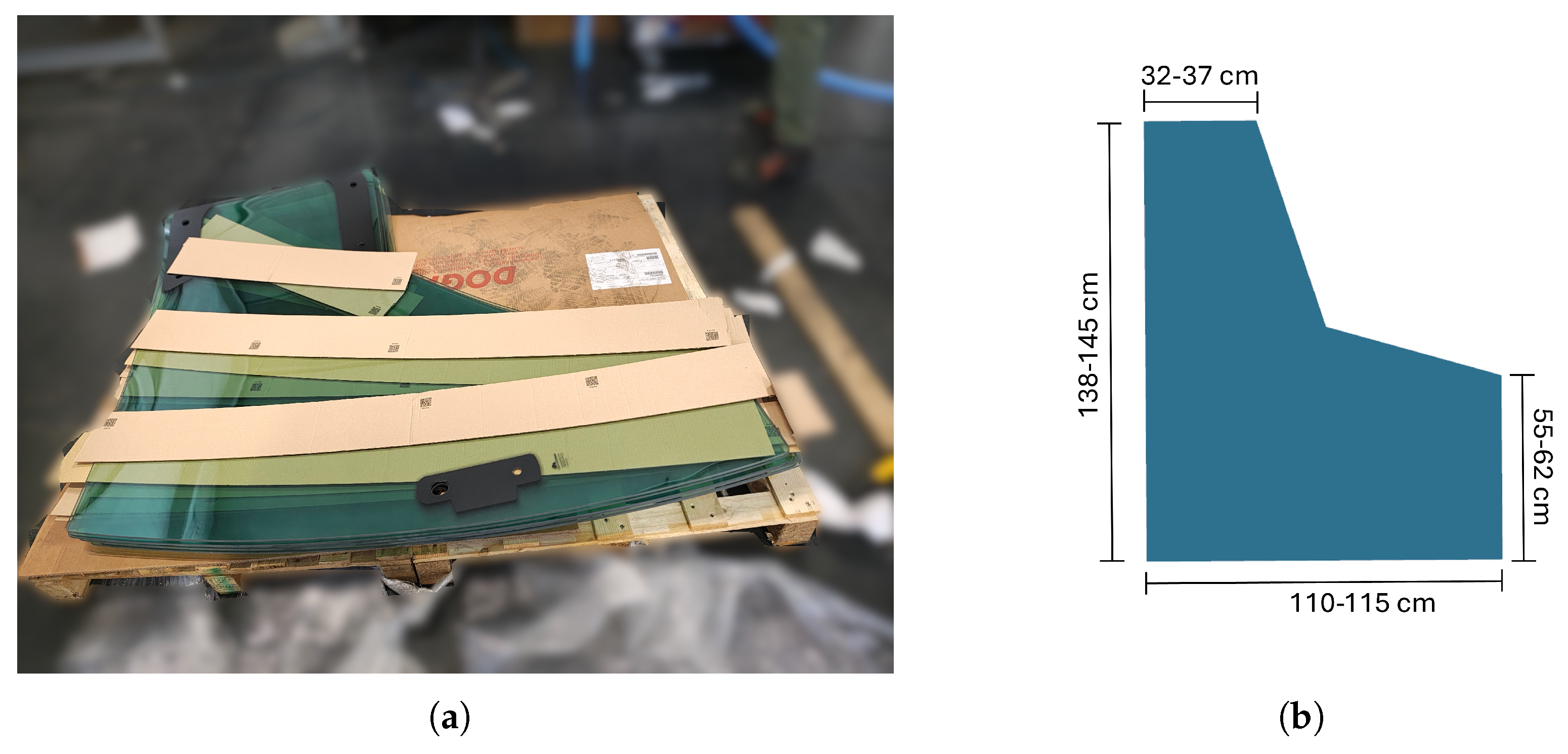
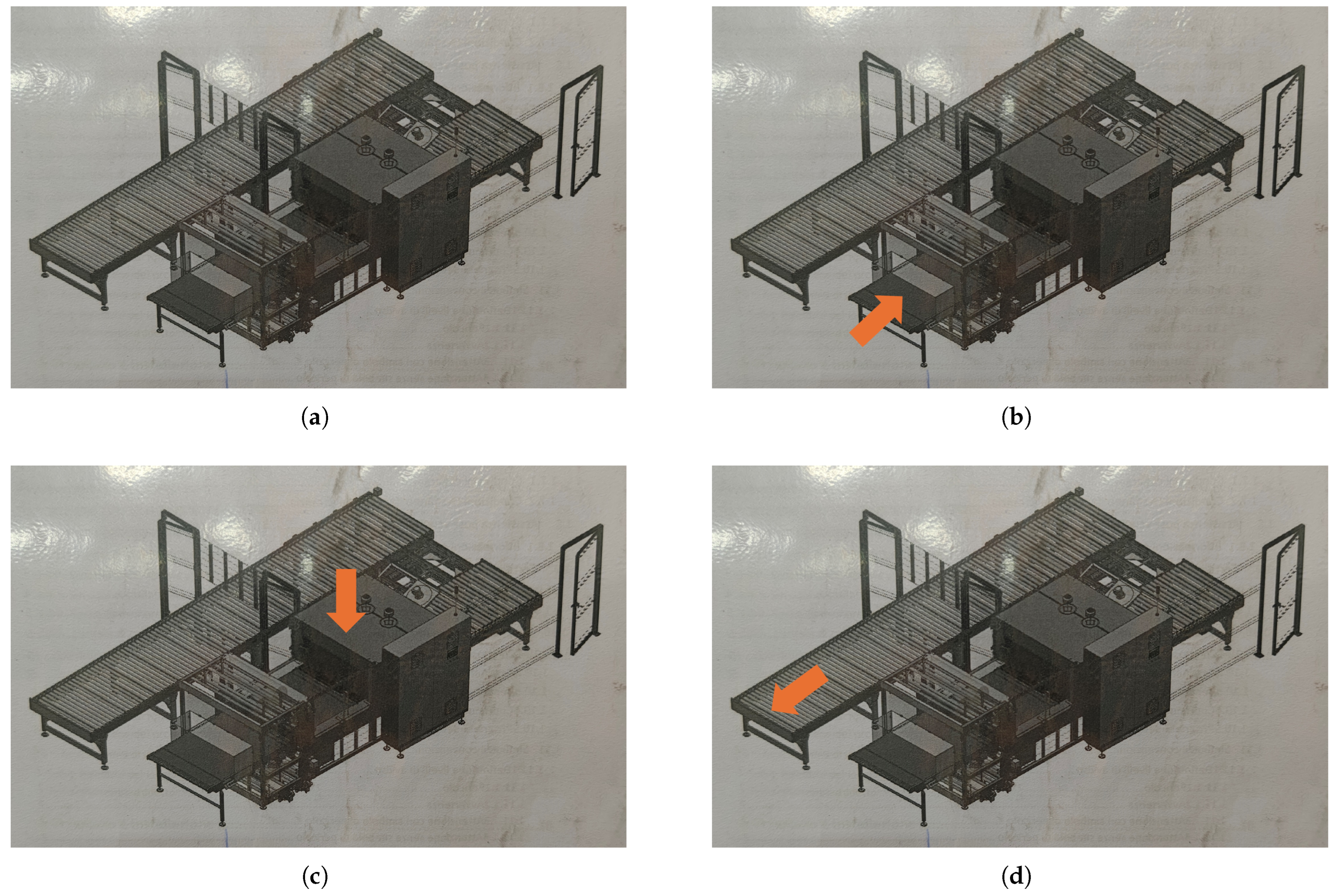
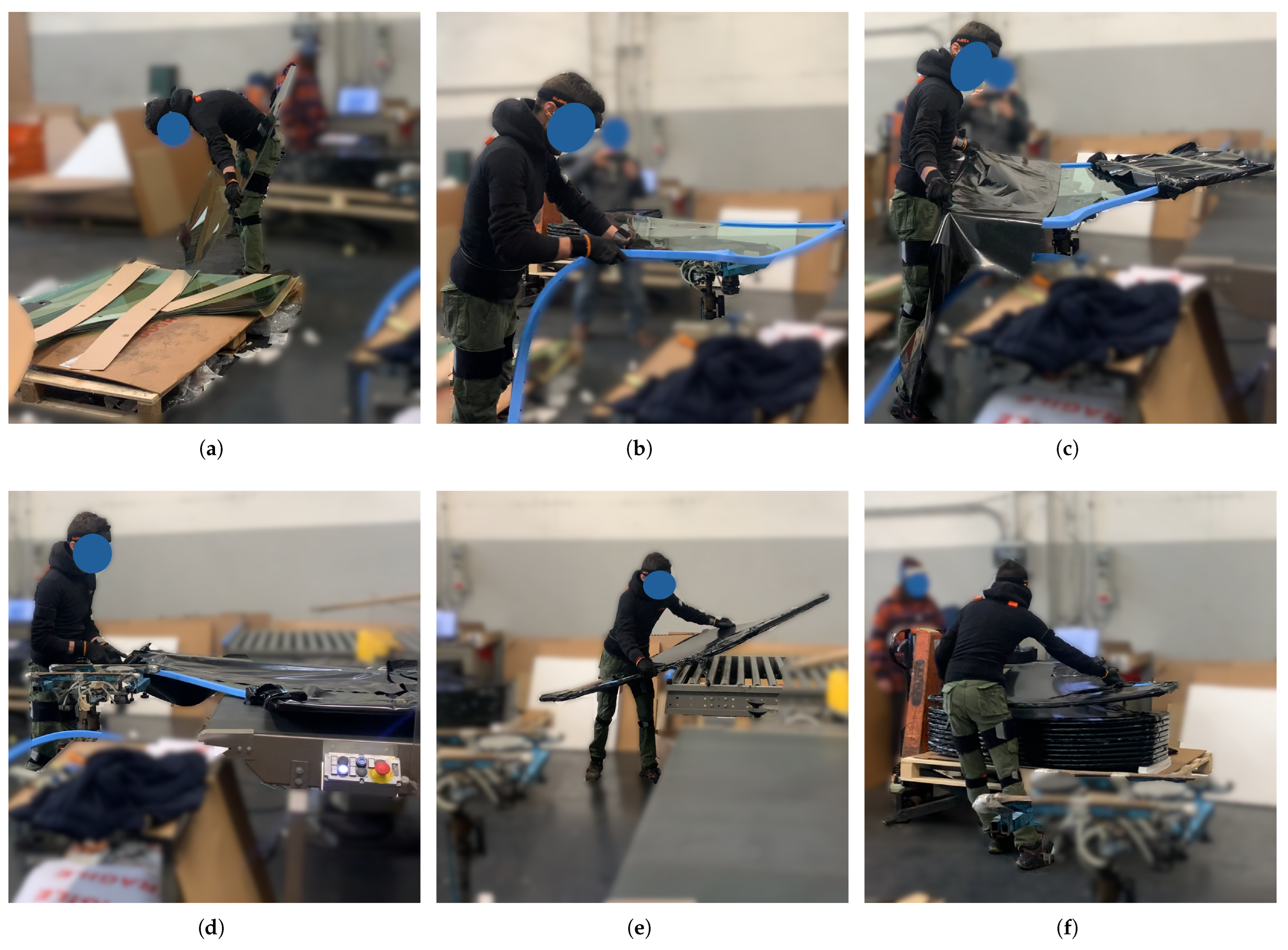
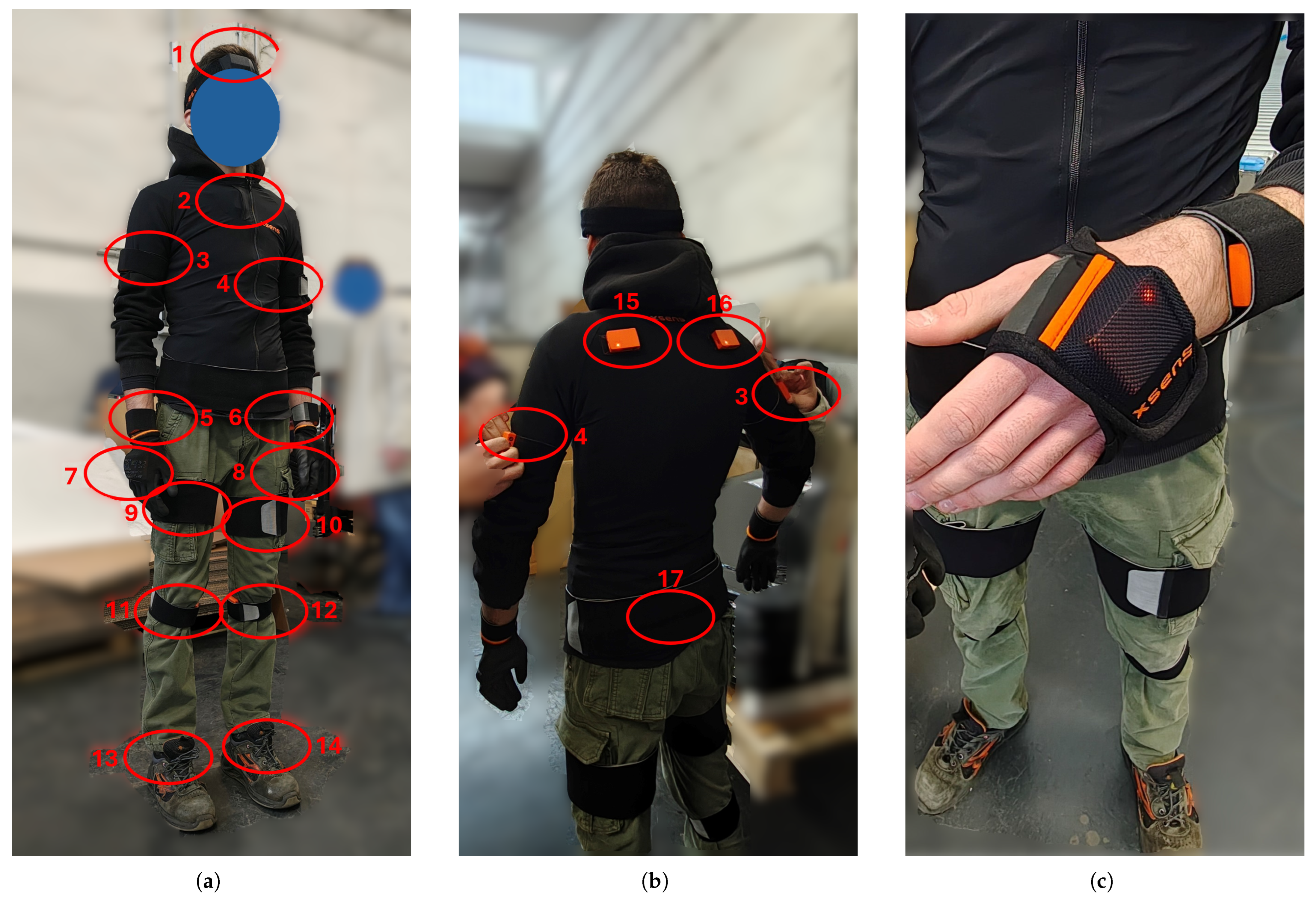

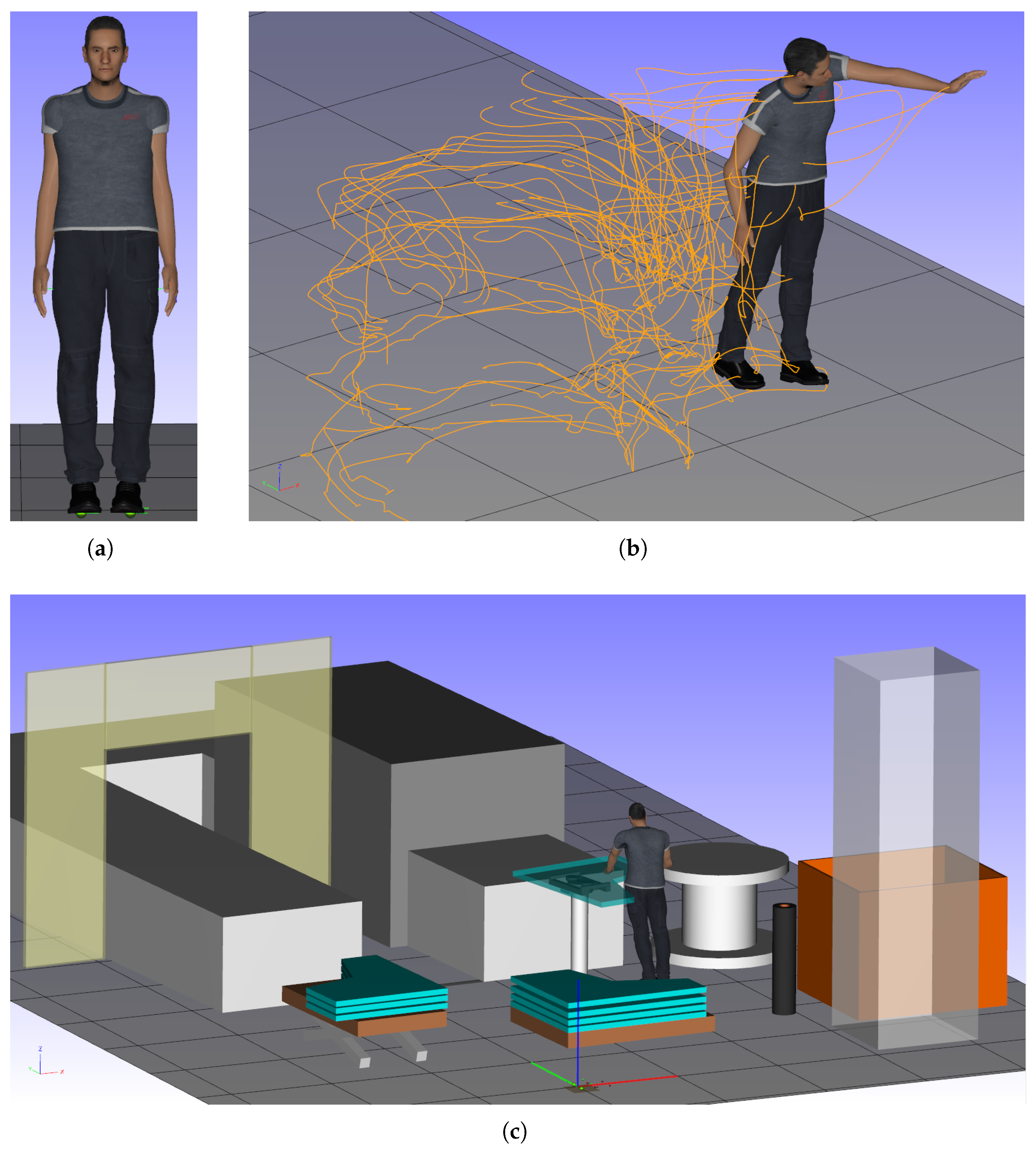
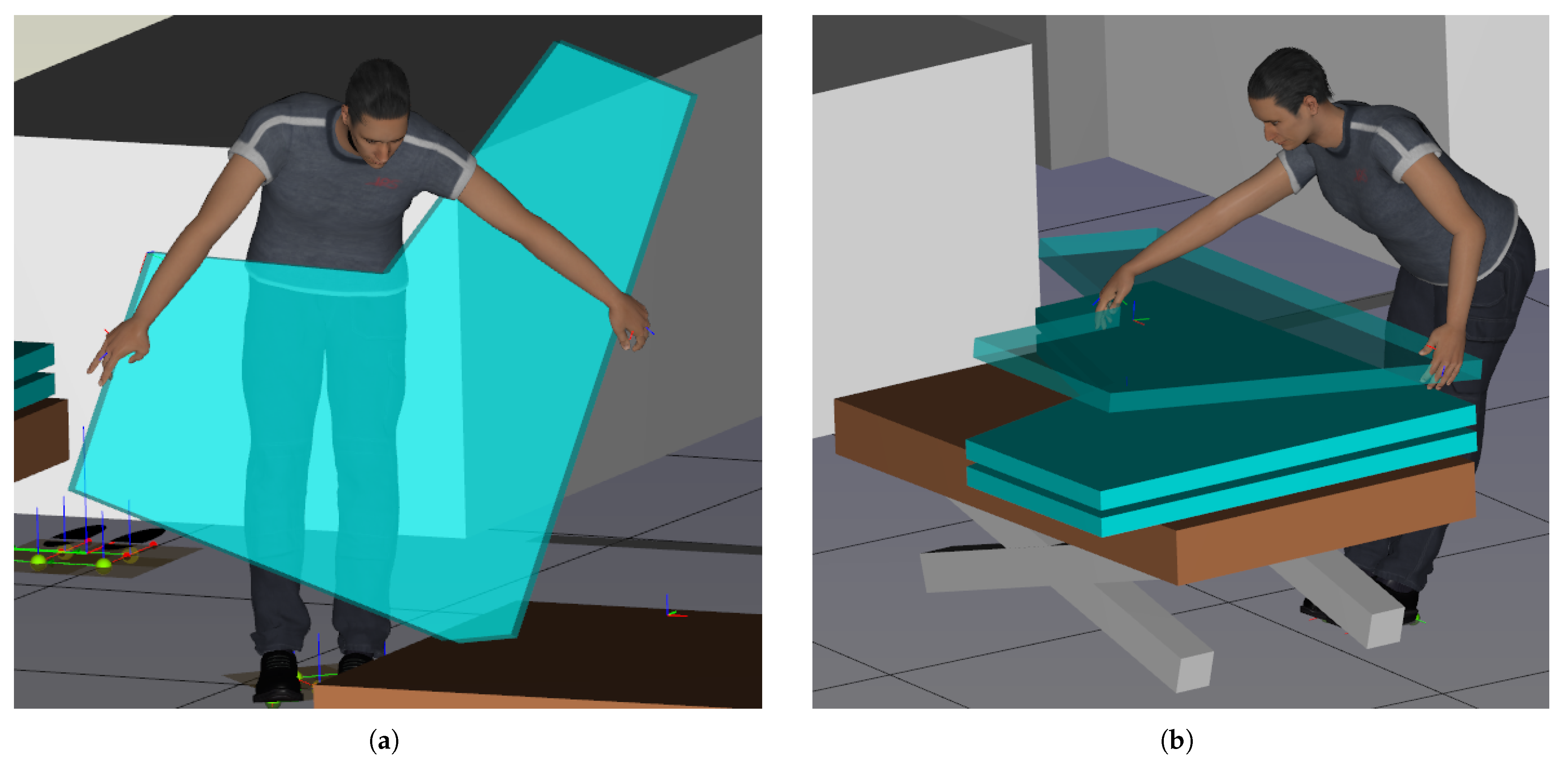
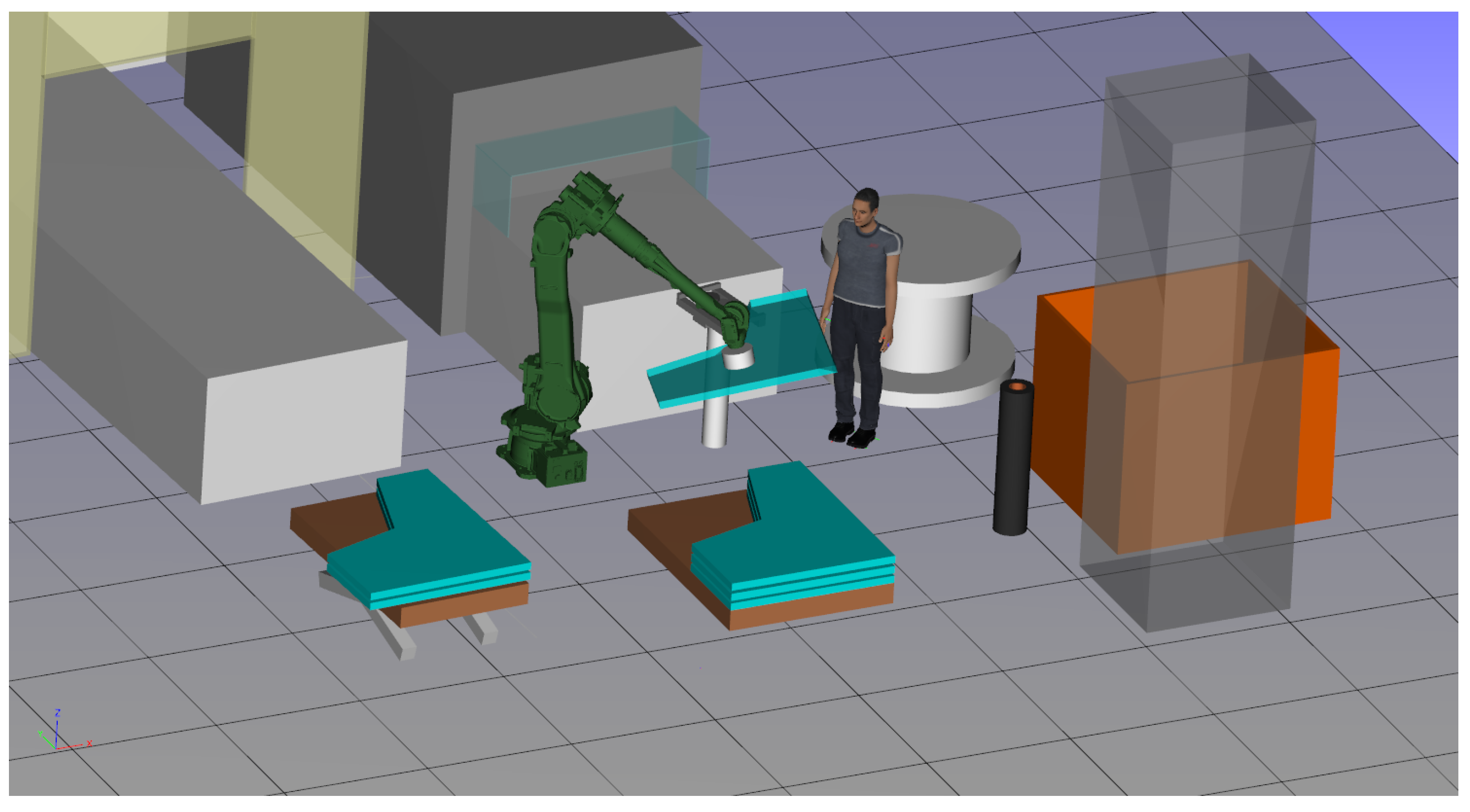
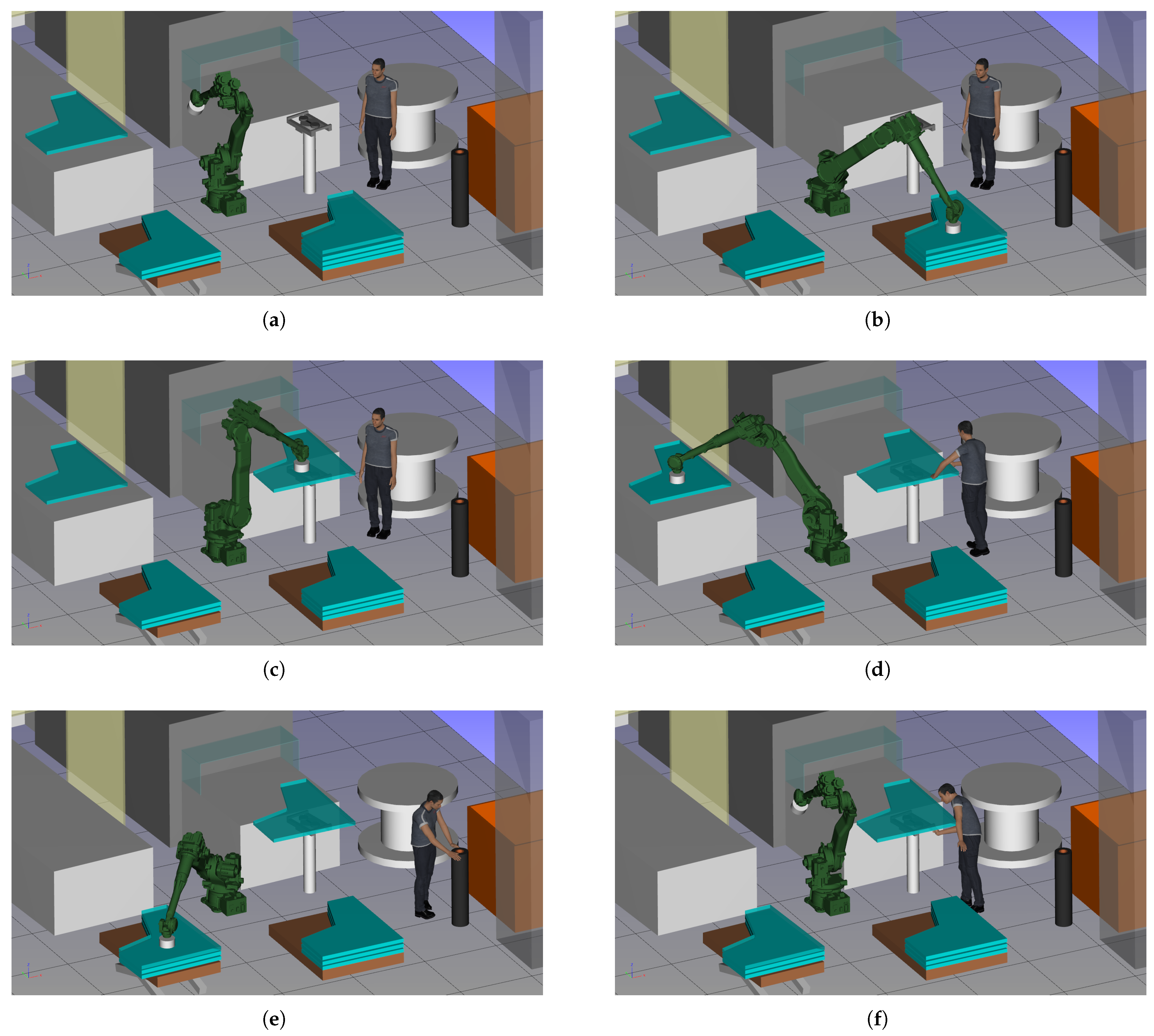
| Windshield Working On | Activity Performed | Time [s] |
|---|---|---|
| Windshield 1 | Packaging removal | 9.7 |
| Gripping windshield | 9.95 | |
| Moving windshield | 4.7 | |
| Suction-cup activation | 2.35 | |
| Protective foam application | 37.55 | |
| First plastic application | 38.75 | |
| Second plastic application | 55.65 | |
| Suction-cup deactivation | 2.4 | |
| Moving on conveyor | 7.4 | |
| Windshield 2 | Packaging removal | 9.7 |
| Gripping windshield | 9.95 | |
| Moving windshield | 4.7 | |
| Suction-cup activation | 2.35 | |
| Protective foam application | 37.55 | |
| First plastic application | 38.75 | |
| Second plastic application | 55.65 | |
| Suction-cup deactivation | 2.4 | |
| Moving on conveyor | 7.4 | |
| None | Walking | 1.6 |
| Windshield 1 | Visual inspection | 4.45 |
| Gripping packed windshield | 3.4 | |
| Moving onto pallet | 4.705 | |
| Positioning onto pallet | 9.345 | |
| Label application | 13.6 | |
| None | Waiting | 31.5 |
| Windshield 2 | Visual inspection | 4.45 |
| Gripping packed windshield | 3.4 | |
| Moving onto pallet | 4.705 | |
| Positioning onto pallet | 9.345 | |
| Label application | 13.6 | |
| None | Walking | 6.78 |
Disclaimer/Publisher’s Note: The statements, opinions and data contained in all publications are solely those of the individual author(s) and contributor(s) and not of MDPI and/or the editor(s). MDPI and/or the editor(s) disclaim responsibility for any injury to people or property resulting from any ideas, methods, instructions or products referred to in the content. |
© 2025 by the authors. Licensee MDPI, Basel, Switzerland. This article is an open access article distributed under the terms and conditions of the Creative Commons Attribution (CC BY) license (https://creativecommons.org/licenses/by/4.0/).
Share and Cite
Bertoli, A.; Nini, M.; Cibrario, V.; Vargas, M.; Perona, P.; Rossi, L.; Benedetti, L.; Nicolinti, A.; Fantuzzi, C. Leveraging Digital Twin Technology with a Human-Centered Approach to Automate a Workstation in the Logistics Sector of Made in Italy: CHIMAR Use Case. Machines 2025, 13, 303. https://doi.org/10.3390/machines13040303
Bertoli A, Nini M, Cibrario V, Vargas M, Perona P, Rossi L, Benedetti L, Nicolinti A, Fantuzzi C. Leveraging Digital Twin Technology with a Human-Centered Approach to Automate a Workstation in the Logistics Sector of Made in Italy: CHIMAR Use Case. Machines. 2025; 13(4):303. https://doi.org/10.3390/machines13040303
Chicago/Turabian StyleBertoli, Annalisa, Matteo Nini, Valerio Cibrario, Manuela Vargas, Paolo Perona, Ludovico Rossi, Laura Benedetti, Alberto Nicolinti, and Cesare Fantuzzi. 2025. "Leveraging Digital Twin Technology with a Human-Centered Approach to Automate a Workstation in the Logistics Sector of Made in Italy: CHIMAR Use Case" Machines 13, no. 4: 303. https://doi.org/10.3390/machines13040303
APA StyleBertoli, A., Nini, M., Cibrario, V., Vargas, M., Perona, P., Rossi, L., Benedetti, L., Nicolinti, A., & Fantuzzi, C. (2025). Leveraging Digital Twin Technology with a Human-Centered Approach to Automate a Workstation in the Logistics Sector of Made in Italy: CHIMAR Use Case. Machines, 13(4), 303. https://doi.org/10.3390/machines13040303







